It’s Always Best to Start at the Beginning!

My First Car(s)
The first car I ever owned was a J reg (1992) Vauxhall Nova 1.2 litre in turquoise green/blue. One day when I have a huge garage full of cars I’m going to have another Nova.

Note: This isn’t my actual Nova, I don’t have a picture of my actual Nova because camera’s weren’t invented yet.
The majority of cars I’ve owned since then have been 3rd, 4th, 5th, 6th all the way through to 10th hand cars, all bought cheap from the back of a newspaper, Autotrader, Facebook Market Place or eBay. Some of my cars have died within a couple of months of buying them and I’ve had to scrap them due to lack of funds or the knowledge to fix them. Others have lasted around a year before failing their MOT then meeting the same fate. A few I’ve managed to have for over a year, maintained and fixed them before selling them on at a loss.
Having three small children has meant we’ve usually needed to buy a “sensible family car” whenever we’ve needed to car shop. Our “sensible family cars” have ranged from the trusty Ford Focus (died), Ford C-Max (sold), through to the Citroën C4 Grande Picasso (died spectacularly) with the “super amazing” ETG6 gearbox (Efficient Tronic Gearbox 6 Speed) that absolutely shit itself in the local Morrisons carpark late one night causing the smallest child to have a panic attack and try to escape the safety of the car and run blindly across the dimly lit carpark crying and screaming with me chasing her, simultaneously trying not to look like a creepy old man chasing a screaming child into the night.
Our most recent “new” car (I was the tenth owner) was another French delight – a 2010 Mark I Peugeot 5008 Exclusive 1.6 litre turbo.
The Problematic Peugeot 5008
To be fair to the 5008, as a family car this was a lovely and comfortable car filled with all the fun little extras; cruise control, digital speedo on a funky little heads up display (helps you to pretend you’re Maverick off of Top Gun),
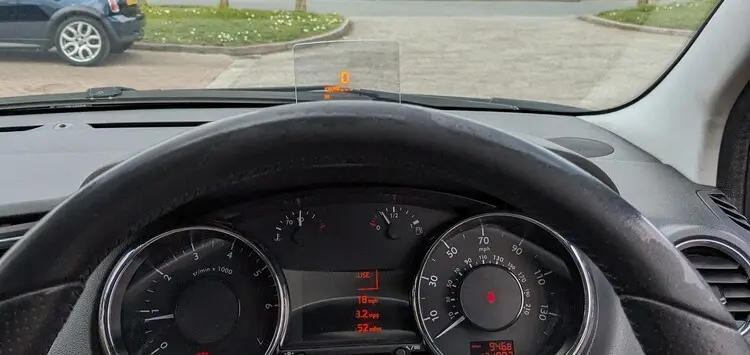
full electric windows, panoramic sunroof, tray tables in the back, built in sun blinds in all the rear windows, arm rests, loads of little storage compartments, and 7 seats that all fold down in a million different combinations, including totally flat to allow for tip runs to be completed in one trip without the need for a special van pass (sold).
The 5008 was purchased from an advert on Facebook Market Place in April 2023 for £1500 after some haggling with 120k miles on the clock (this is probably the most we’ve ever purchased a car outright).
The seller told me there were only a couple of minor issues with the car; issue 1 – they’d had a slight altercation with someone at some point and said person had returned to the car with a key/screwdriver/sharp implement [delete as appropriate] in hand and keyed every body panel on the car. Issue 2 – there was a noise whilst driving but the seller assured me “their mechanic” had looked over the car and the noise was a failing wheel bearing. Apart from those two issues everything else was “absolutely spot on”.
The intensive test drive we went on (around 15 minutes) confirmed to me and my vast car knowledge that there wasn’t anything majorly wrong with the car; no rattles, nothing fell off, gear changes were smooth and easy, the accelerator accelerated the car, the brakes did the stopping of the car. Once we arrived back at their house I commenced the bartering process and successfully knocked £200 off the asking price (I was pretty much The Wolf of Wall Street in that moment).

Hand shakes happened, money was transferred, a V5C form was completed and in April 2023 the Peugeot was bought with 11 month MOT still on it.

Happy Fun Times!
Issue 1: Scratch Attack
Issue 1 was the paint work, every body panel on the 5008 had been attacked and scratched by an angry person with a sharp implement of some kind. I could live with this though, at the time I really wasn’t that fussed about the paint work and I pencilled this in to be fixed another time.
Issue 2: “Wheel bearing”
I’ve had wheel bearings fail on me before, I’ve heard them begin to hum, I’ve had them start to grind, and I’ve had them catastrophically fail on me. However, this failing wheel bearing (100% assured by a “real mechanic”) didn’t sound like any of the previous failing wheel bearings I’ve witnessed. This “wheel bearing” noise was a kind of knocking/clunking sound accompanied by an occasional grinding noise. Time for a quick inspection.
Now, in my head this inspection played out something like this;
- Grab the jack and tyre iron out of the shed
- Start on one corner of the car and work my way around
- Jack the car up
- Wheel off
- Find something loose/broken or repeat process until something bad is found
- Repair/replace broken component
- Wheel back on
- No more noise
- Fixed
Side note: my secret weapon in my car fixing journey is my heterosexual life partner, P. Not only is P my best friend but he’s also the human version of a car encyclopaedia. He knows everything there is to know about every car, engine, component ever made (plus many other interesting things that aren’t car related). P has passed on and helped me learn many, many things, especially just plain old confidence when it comes to car maintenance.
P came to help problem solve the “wheel bearing” noise and whilst I was going to grab the jack from the shed (remember, we’re in a car park out the front of our house and the shed is located in the back garden) he began to loosen the wheel nuts on the drivers side front wheel. This is where he discovered the wheel nuts where (barely) finger tight!
Yes, this was a terrifying discovery.
No, I have never once considered checking the wheel nut tightness when buying cars.
Yes, I will now forever check the wheel nut tightness on every car I buy in the future.
On a positive note, this did in fact fix the “wheel bearing” noise. No more grinding or clunking when driving, HOORAY! On another positive note, this was the first (and cheapest) fix on the Peugeot 5008.
Issue 3. The illusive air leak
After a week of owning the Peugeot that heart-sinking feeling happened – the little orange engine management light woke up on the dash.
“FFFUUUCCCKKK! I’ve been scammed” went my internal monologue, followed by feelings of anger, embarrassment, sadness, and worst of all, panic. Panic that we’d yet again be searching for a car, this time having thrown £1500 at a dud car and having no spare money for a new one!
After my initial emotional overload I booked an appointment with Swiss Army P who instantly reassured me that engine management lights don’t actually mean instant car death and nearly anything on a car can be fixed (who knew?).
Let the Hunt Commence!
According to P we needed an OBDII fault code reader – Aldi Special Buy for the win!

For the amazing price of £7.99 an OBDII fault code reader was purchased (Aldi Special Buys will feature a lot in this blog and I have no regrets about that!). I plugged the reader into the OBDII port, located behind a plastic cover in the glove box, and fault code P2279 appeared. As any professional mechanic would do I cleared the code and proclaimed it fixed!

Of course, on the way to work the next day the EML appeared again and when I plugged the OBDII reader in, fault code P2279 had re-appeared (shock horror!). At the same time I also noticed something else that seemed a bit weird, the radiator fan was doing strange things: whenever I switched the engine off, the radiator fan spun at 1 million RPM for a good five to ten minutes and whenever I switched the engine on, within a couple of minutes it spooled up and ran at the maximum speed continuously.
Feeling beaten I turned to the trusty Google search.
“Peugeot 5008 Mark I 2010 1.6 turbo fault code P2279” seemed like a good starting point.
After trawling through endless forums with people having similar issues/fault code, but no one really answering the question with a fix, the only thing I learned was P2279 referred to an ‘intake air system leak. A few days went by and then a new side quest popped up; my battery started dying. I engaged my brain and came to the conclusion that the fan running at 1 million RPM for a good five to ten minutes after the engine was switched off was obviously draining the battery until I happened to notice these beauties…

The world famous, Lewis Hamilton approved ALOPEE headlight bulbs, by the looks of it, bought off of Ali Express. These bulbs seemed to be on all the time, even when the car was turned off and locked, the bulbs still had a slight dim glow. I removed these bulbs and replaced them with some normal headlight bulbs which seemed to stop the battery dying – YAY, side quest complete!
However, the fan and the EML were still an issue. The following Saturday, I got up early and ventured into the carpark, opened the bonnet and started to try and have a nosey around the engine bay just to see if there was anything obviously wrong/not connected/broken.
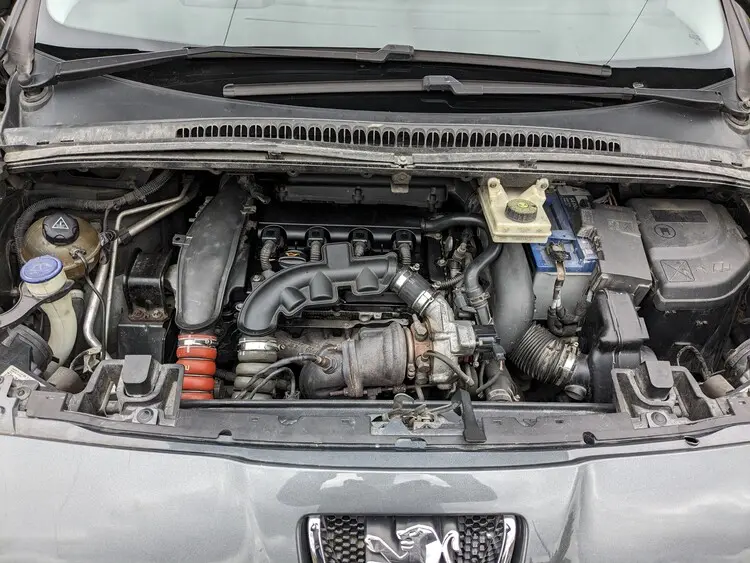
With the help of P, I removed all the air pipes and hoses, checked them for splits or damage and carefully reinstalled them but we didn’t find anything obvious. After reinstalling everything, I cleared the fault code again but, again, it came back on after a short drive.
This fault code bugged me for a couple of weeks, I took out all the hoses and pipes a few times, reinstalled them all, tightened up all the various clips, stared into the engine bay with the engine off, stared into the engine bay with the engine running but nothing jumped out at me.
Side note: I did notice there were lots of loose/missing clips and various fixings but we’ll come back to that later.
After all the time I’d spent under the bonnet of the Peugeot, I began to learn a lot about the car, I began to feel like I knew it inside and out. I began to convince myself that under the sound of the engine running I could hear a slight hissing noise. Nobody else could hear this hissing sound but I knew deep down it was real and not made up.
After many, many chats with P, he came to the conclusion this could be a faulty PCV valve (positive crankcase ventilation valve). I’m not even going to pretend I understood what or how it works but after some more forum trawling and YouTube watching we found that the PCV valve was situated in the top of the rocker cover and a whole new rocker cover would be needed.
Lesson time: A positive crankcase ventilation valve (PCV valve) is a one way valve that recycles harmful gases that build up in the engines crankcase helping keep harmful emissions inside the engine.
My First Real Pretend Mechanic Job
After studying a few hours of YouTube videos on rocker cover replacement on a 1.6 THP engine I began to feel my confidence building and I believed I had the skills to tackle this job!
This is the YouTube video I found the easiest to follow:
After some research I decided to purchase this new aftermarket rocker cover from eBay for £55.71:
ENGINE Cam VALVE Rocker COVER & GASKET FOR CITROEN PEUGEOT 1.6T Turbo engine | eBay
Note for the future: There were cheaper options that came without the gasket but from my research I’d learnt that gasket replacement is always the best thing to do whenever you have the option, orrrr… you could go for the cheaper option without the gasket because then you might get to do the same job twice, exciting!
Then one hot Friday night in May after work I started my first real pretend mechanic job!
Whilst following the YouTube tutorial I successfully removed the old rocker cover and this is what I found:
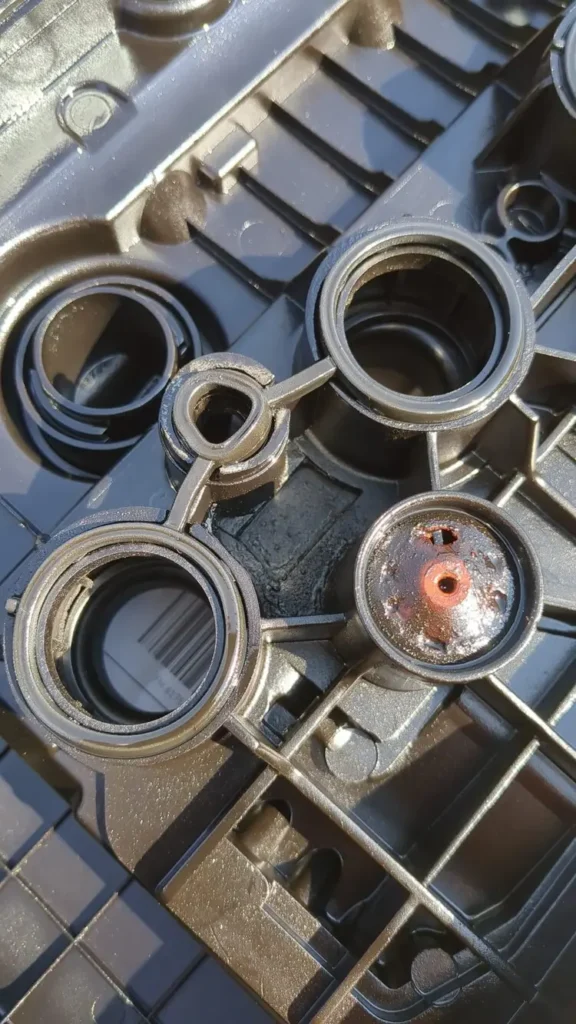
I’m not going to lie, this felt FUCKING AMAZING! Not only was I successfully doing big boy things in a real engine on a real car, I’d also found a thing that looked broken and it was right where I thought it should be!
Flash back: remember the note for the future? Well, alongside the degraded PCV valve (the damaged-looking orange rubber circle with holes in that shouldn’t have holes in), it looked like there was a damaged gasket too! Double Win!
I removed the old rocker cover, used some engine degreaser to clean up the surfaces on the top of the cylinder head where the rocker cover sits, seated the new gaskets into the new rocker cover and replaced the rocker cover.
I used the below diagram to tighten the rocker cover bolts to 10 Newton Metres of torque in order from 1 to 13 (yeah, I didn’t have access to a torque wrench that could go as low as 10 N/m so I just used my totally uncalibrated arms and guessed what I thought 10 N/m would feel like).
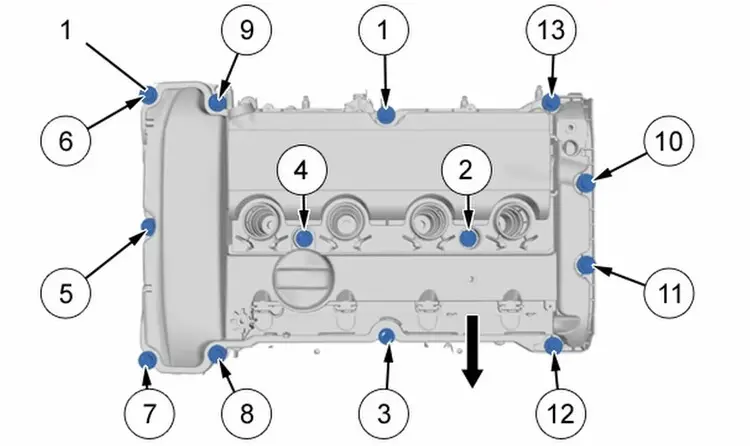
I then replaced all the pipes and hoses I’d had to remove to gain access to the rocker cover and cleared the engine management light using the OBDII fault code reader.
I then sat in the drivers seat quietly for a long minute hoping this was the fix of all fixes. I turned the ignition on; the car started up first time which meant I hadn’t destroyed the engine with my awesome ‘mekanic’ skills! Then I listened. And I listened, and the fan did not spool up to hyper speed; it stayed quiet! I took the car for a test drive expecting the EML to light up the dashboard or the engine to fall out but there was no EML on the dash and the engine stayed in! This felt so good! I’d actually fixed the car with my own hands all by myself! What a feeling!
Issue 4. Captain, We’ve Sprung a Leak!
‘WARNING LOW COOLANT STOP!’
Well, this isn’t a fun warning light to have, it’s actually quite aggressive and scary.
I’d just jumped in the car to go to work one morning a few weeks after fixing the PCV valve and I was greeted by a low coolant warning so I popped the bonnet, opened the coolant expansion bottle lid located at the top left of the engine, (just a little safety FYI: it’s probably not a good idea to do this if the engines hot unless you enjoy being scalded by super heated steam), and saw the coolant bottle was empty. So I did what any seasoned mechanic would do in my situation; I ran inside, filled an empty milk carton up with tap water and topped the coolant up, closed the lid, shut the bonnet and drove to work. All seemed fine until the end of the day when I left work and was greeted by that aggressive warning light again. BOLLOCKS!
I used my new friend, the trusty milk bottle again and topped up the coolant and managed to get back home to the carpark garage, made a coffee whilst the engine cooled down and went out for a nosey around to see if I could see anything obviously wrong.
Remember my side note from earlier: “Side note: I did notice there were lots of loose/missing clips and various fixings but we’ll come back to that later.”. Well, it’s now later and we’re coming back to it now.
From my learning journey of taking the engine to pieces and rebuilding it over and over, me and P had come to the conclusion that the previous owners “own mechanic” who’d diagnosed the “wheel bearing” wasn’t a fan of putting bits back together as they found them, they did however enjoy throwing clips and fixings away (probably a weight saving measure when racing the 7-seater 5008). After jacking up the car and taking a good look underneath I noticed a big, fat hose just hanging down. It was flopping about around the drive shaft on the drivers side. It was quite evident that the hose had been rubbing against the drive shaft for a while now, mainly due to the huge hole that had rubbed itself into existence, thus, not allowing the coolant to actually stay inside the coolant system!
I laid under the car and tried to feel my way up the coolant hose to wherever it went but it disappeared behind the back of the engine somewhere where I couldn’t reach or see. After some Googling and YouTube watching I decided that rather than buying a new coolant hose, dropping the engine down (remember I’m in a car park), unclipping and replacing the hose, jacking the engine back up and repairing it in that way, a bit of 15mm pipe and a couple of hose clips would be a lot easier of a fix.
I know this isn’t “the correct way” to repair this but I don’t have the money to send it into the garage to be fixed or the tools to drop an engine down so I did what I did and it worked so it’s all good!
The internal bore of the hose was the perfect size for a small piece of 15mm copper pipe to slide into, so I chopped the hose away where the unwanted hole had appeared, slid a hose clip over the end of each piece of hose, slid a 10cm-ish long copper pipe inside each end of the hose and then tightened the hose clips up nice and tight clamping the copper pipe in place. I grabbed my trusty milk bottle and refilled the coolant system. The next morning when I checked the coolant level it was still full! Yay!
Side note: Now, eagle eyed people or actual real life mechanics might have noticed that I’d now filled my coolant system up with good old tap water. This might become a future problem, a future problem that, at the time, I was unaware of.
Issue 5. Hello, My Old Friend
When buying the Peugeot 5008 my initial plan was to spend some time and effort cleaning up the paintwork, getting rid of the scratches and making it look nice and shiny. So far I’d found myself just fixing fault, after fault, after fault.
Exciting news though, the engine management light had come back on again – Whoop! Whoop!
I betrayed Aldi this time and invested in a fancy little Bluetooth OBDII reader:
Torque ELM 327 Bluetooth V2.1 OBD2 OBDII Car Diagnostic Auto Scanner Code Reader | eBay
And I bought and downloaded the TorquePro app onto my phone after a recommendation from P:
Torque Pro (OBD 2 & Car) – Apps on Google Play
I plugged in the new OBDII reader, opened TorquePro, went through the initial set up and then scanned for a code. I was thinking my PCV valve fix may have failed and was expecting to see a P2279 code pop up but instead I was greeted with a new scary sounding fault code:
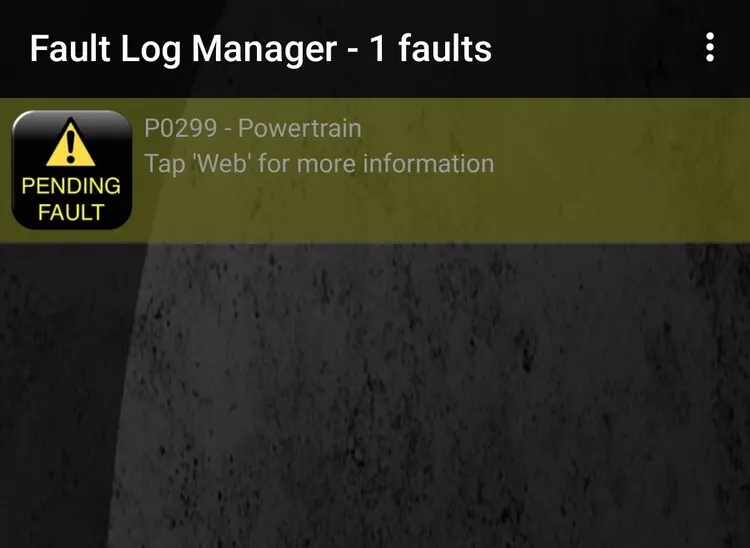
P0299 – Powertrain. I had absolutely no idea what a ‘powertrain’ was, but it sounded very exciting.
I turned to trusty old Google for some answers: A P0299 powertrain code indicates an under boost issue in a vehicle’s turbocharger or super charger system.
A turbo issue! Fuck! Turbos are expensive! Expensive fixes usually mean bye, bye car for us; this could be the end of the 5008.
What’s worse is now when I’m driving I’m starting to notice the lack of boost. As far as I know, 7 seaters aren’t really known for their handling and speed but even so, now that I thought about it and I’d tuned into the sound and feel of the car, I’d never really noticed any kind of boost or acceleration aid, it just kind of drove along accelerating slow and steadily. I started to think the little turbo in the 5008 wasn’t actually doing any turbo-ing.
Although this was a scary, it felt good to have already narrowed down the fault to one specific area of the engine to investigate; the itty-bitty turbo charger. Luckily for all involved, the little turbo on a 1.6THP engine is located top, front and centre of the engine allowing for easy, stand-up-able access opposed to awkward, laying-down-able access like most jobs on cars seem to be.
Lesson time: a turbo charger is a small fan that spins stupidly fast and forces extra air into your cars engine. More air in the engine means more fuel can be burnt which in turn means more power.
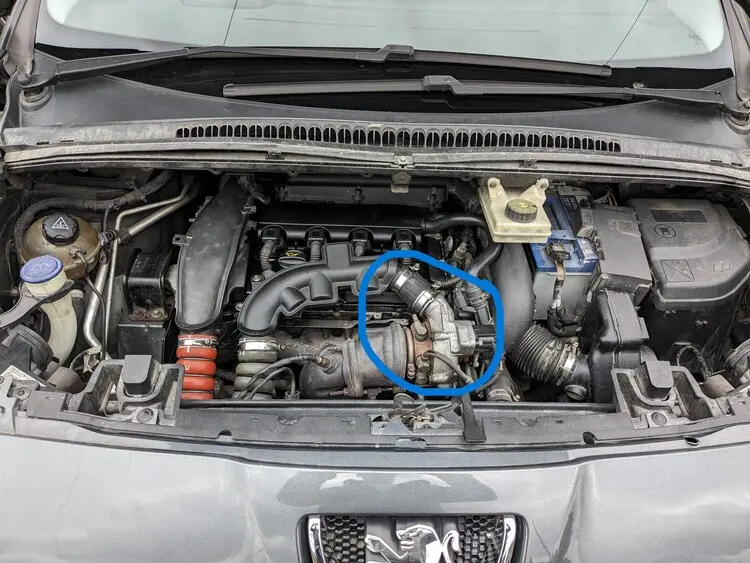
Circled – The little tiny turbo
The turbo is connected to the exhaust manifold with three bolts. In between there’s a thin metal gasket triangular in shape. I unscrewed the bolts and separated the two as far as I could (maybe a couple of inches). I managed to wriggle my fingers inside the turbo and have a feel around. The impeller inside the turbo felt sturdy and moved freely, I deployed P to have a feel around too and he confirmed everything felt good, there was no play in the impeller and there was no visible signs of oil in the turbo either. Phew! This was good news and made me feel a little better.
Satisfied the turbo was not catastrophically dead I put everything back together and consulted Dr Google again. After trawling through some forums I found a little thread describing the same fault code and various causes; one cause was a faulty wastegate.
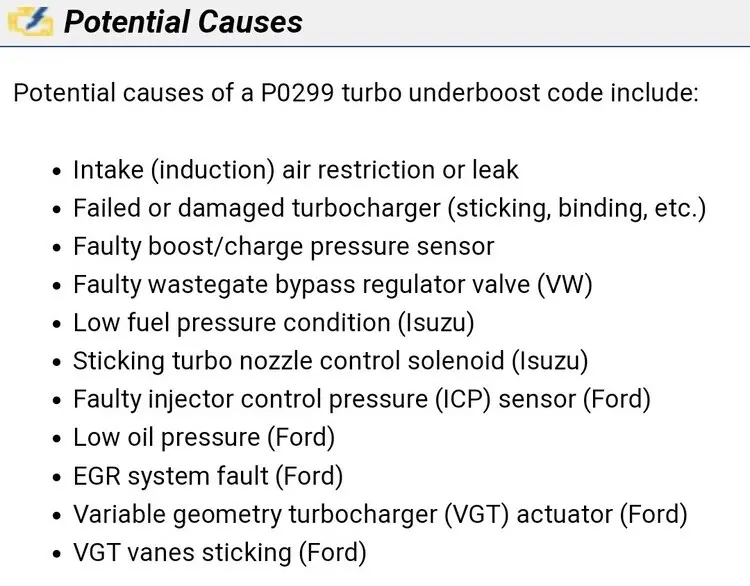
Lesson time: A wastegate acts like a pressure relief valve for the turbo charger. A turbo charger’s job is to force air into the engine creating more power. Too much forced air, can damage the engine so the waste gates job is to prevent this happening. If the wastegate isn’t working properly then the P0299 fault code can be thrown up.
After some more reading about wastegates I came across a DIY style test and all I needed was a big syringe, some silicone hose, a lighter and a pencil. I already had access to a lighter and a pencil so I jumped on Amazon to order syringe and hose which arrived the next day. After some gentle manipulation with fire and shoving a pencil into the silicone hose to make it wider, I managed to connect the hose to the syringe and make the below contraption.

I took my cool new tool to the car, disconnected the vacuum hose from the wastegate and connected up the silicone hose. If the wastegate was working as it should be I’d be able to pull the syringe out and the wastegate would maintain pressure, creating a vacuum and the syringe would be sucked back in; it worked! Great success!

The next “fix” I’d come across was replacing the diverter valve, or blow off valve. The diverter valve is located on the back of the turbo charger and looks like this:

I ordered one for £20 and swapped it out. This was a nice easy replacement, three hex-bolts is all that held it on. I cleared the fault with the OBDII reader and went for a drive but there still wasn’t any boost happening and shortly afterwards the EML came back on – bumsy!
Whilst I’d been buying and making my own tools, and swapping out components, P had been doing his own research in the back ground. I think this problem had captured his attention and he’d fully engaged his mega-mind. Somewhere along his adventure he came across this diagram of all the vacuum lines on the 1.6 THP engine:
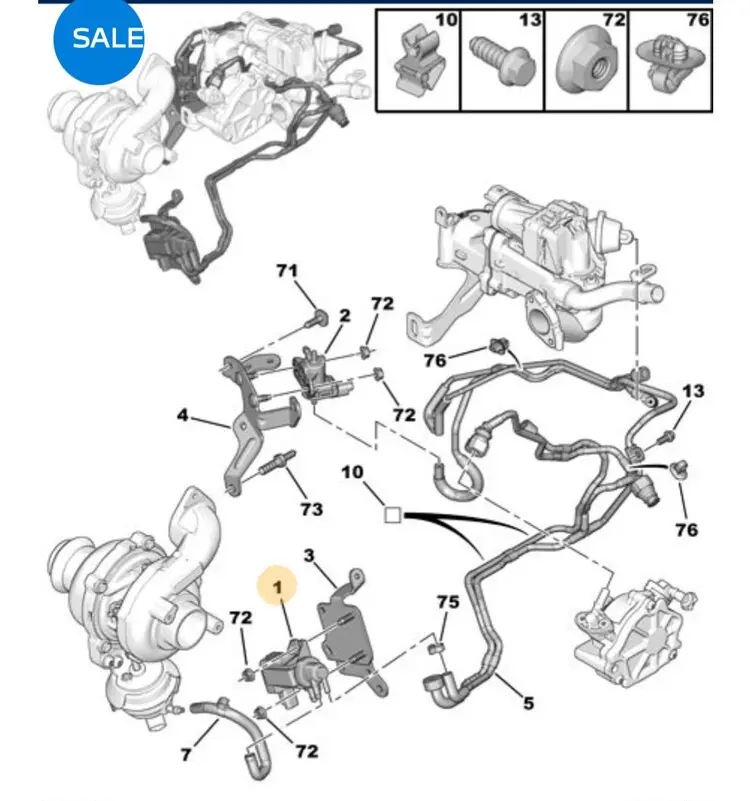
Using this diagram we started fishing around in the engine bay trying to chase vacuum lines around, in and out, and down the back of the engine and deep down in the dark, dark depths of the engine bay I found a random vacuum line just flopping around and not attached to anything!
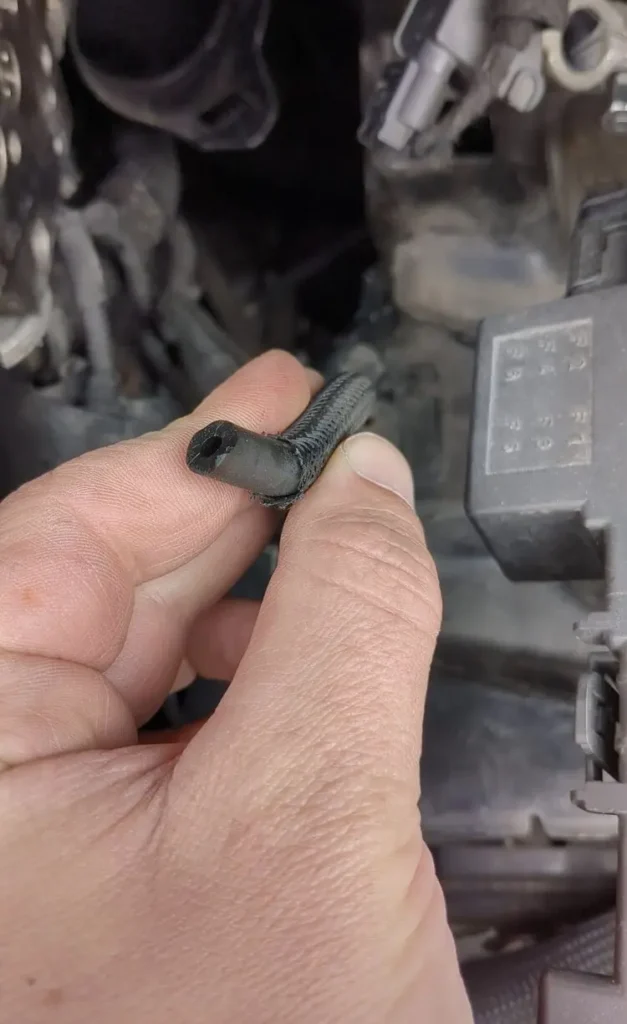
Who are you and where did you come from little hose?
Although this was partly-positive news, and progress was being made, this was still a mystery vacuum line and I still needed to find it a home. We looked at the diagram and P found the little vacuum pump mounted on the right hand side of the engine. After a quick inspection it became obvious pretty fast that this little line I’d found looked like it did indeed live here – yay! The only issue was that the nipple the hose attached to was snapped off. We removed the vacuum pump and gave it a little clean up, I used some Gorilla Glue (sourced from the middle isle at Aldi) and with very steady hands, glued the nipple back on to the pump and left it to dry. The pump was re-attached successfully, the hose was pushed onto the nipple, EML cleared and I set off for a test drive.
Immediately the car felt different, I had boost! I had actual boost! I could feel the turbo kick in when I accelerated and after a short drive the EML stayed off. Yay! Finally, I had a fault free, working car!
Karma is a Cat
“FiNaLlY, I HaD a FaUlT fReE, wOrKiNg CaR”
What a stupid thing to think!
‘WARNING LOW COOLANT, STOP!’
Not again! Not the coolant hose again! I popped the bonnet to check the coolant expansion bottle expecting an empty bottle but it was sitting at the correct level. Checked underneath the car to look at the previous repair; all looked dry. Well that’s interesting? I turned the car back on and the warning had disappeared.
Fixed? Possibly a glitch in the Matrix? Who knows?
It was now August and over the next week or so the low coolant warning light flickered on and off at various times, I kept a close eye on the coolant level but it didn’t drop at all. A Google search led me to believe this was a faulty coolant sensor so I ordered a new one. When it arrived, I went to change the sensor and I found a very poorly looking sensor covered in some sort of brownish slime.
Flash back to when I filled my coolant system with water
Whoopsie-daisy!
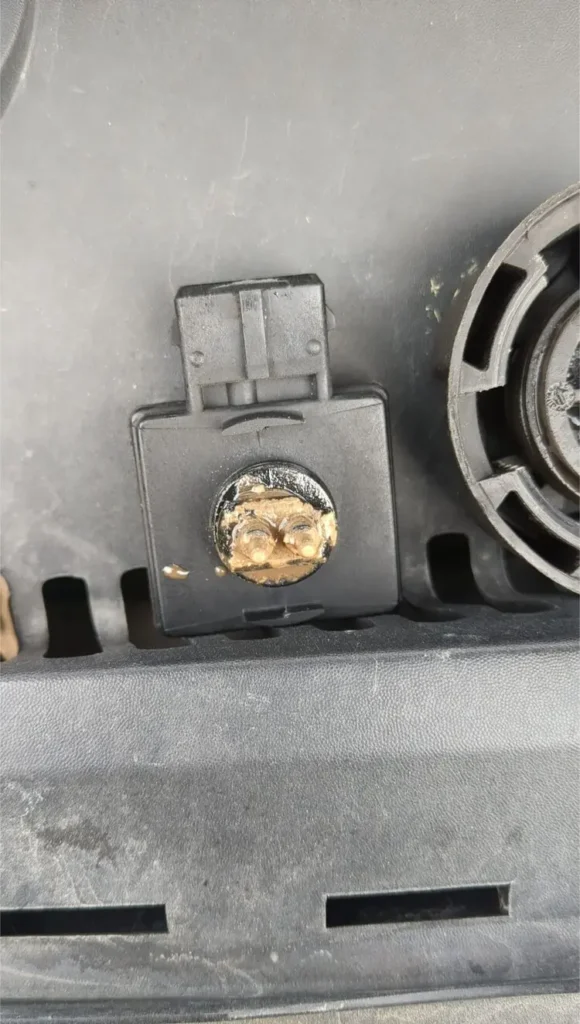
So, it turns out cars use special coolant for a reason – who knew? I think the water I’d used had reacted with the metal prongs on the sensor as it was being heated and cooling down, causing the build up and making the sensor throw up random faults. Once I fitted the new sensor the coolant warning fault disappeared – good news.
Au Revoir!
As far as 7 seaters go, the 5008 did us well for over a year but every time I fixed a something, something else went wrong. I was forever chasing faults and it was beginning to get a bit tedious and I was beginning to dislike the car. I put it through an MOT and put it up for sale. After some faffing and price adjusting it finally sold (sold).
Let’s Begin at the Beginning
It seems kind of weird that this is a blog documenting a little German car build and all I’ve done so far is talk about repairing a big French car but that big French car was a big part of the journey. I learnt a lot about car repairs and maintenance. It helped me build up confidence and helped me realise (along with P’s mentality) that most issues can be fixed if you just spend some time, effort and patience.
The 5008 was sold on a Sunday lunchtime, the Golf was bought on the Sunday evening. I can genuinely say that after years of sailing 7 seaters and family cars the 1.9 TDi Mark V Golf felt like an F1 car! It was genuinely the most fun I’ve ever had driving a car.
The future of this blog is going to be documenting the life of our Mark V Golf and all the ups and downs.
Obi x
P.S. Feel free to leave me a comment, ask a question or tell me I’m not a real mechanic 🙂
